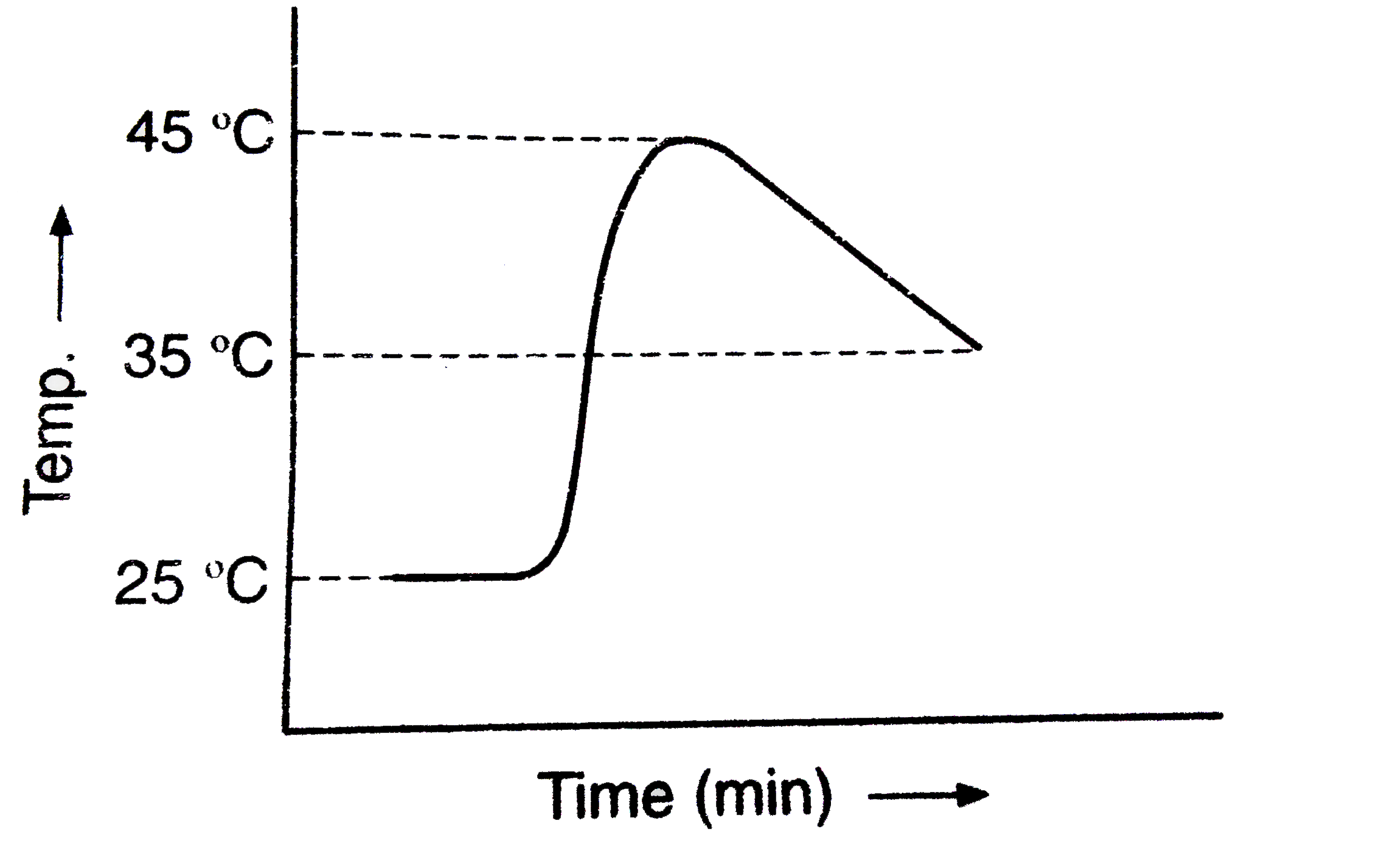(A) As temperature increases, heat of reaction also increases for exothermic as well as endothermic reactions. ltBrgt (R) ΔHreaction varies according to the relation:
ΔH2−ΔH1T2−T1=ΔCP.
If both (A) and (R) are correct and (R) is the correct explanation for (A).
If both (A) and (R) are correct but (R) is not the correct explanation for (A).
If (A) is correct but (R) is incorrect
If (A) is incorrect but (R) is correct.
The correct Answer is:D
Step by step video, text & image solution for (A) As temperature increases, heat of reaction also increases for exothermic as well as endothermic reactions. ltBrgt (R) DeltaH_("reaction") varies according to the relation: (DeltaH_(2)-DeltaH_(1))/(T_(2)-T_(1))=DeltaC_(P). by Chemistry experts to help you in doubts & scoring excellent marks in Class 12 exams.
Topper's Solved these Questions
- BOOK - OP TANDONCHAPTER - Chemical Thermodynamics and ThermochemistryEXERCISE - Assertion Reason Type Question Set-21videos
Chemical Thermodynamics and Thermochemistry
- BOOK - OP TANDONCHAPTER - Chemical Thermodynamics and ThermochemistryEXERCISE - Matric Matching Type Questions3videos
Chemical Thermodynamics and Thermochemistry
- BOOK - OP TANDONCHAPTER - Chemical Thermodynamics and ThermochemistryEXERCISE - Objective Question Level B Set II8videos
Chemical Thermodynamics and Thermochemistry
- BOOK - OP TANDONCHAPTER - CHEMICAL KINETICSEXERCISE - LINKED COMPRESHENSION TYPE QUESTIONS ( SECTION-VI)4videos
CHEMICAL KINETICS
- BOOK - OP TANDONCHAPTER - CLASSIFICATION AND NOMENCLATURE OF ORGANIC COMPOUNDS EXERCISE - INTEGER2videos
CLASSIFICATION AND NOMENCLATURE OF ORGANIC COMPOUNDS
Similar Questions
Define ΔH.What will be the sign of ΔH in
(i) exothermic reaction and
(ii) endothermic reaction?View SolutionChemical reactions are invariable associated with the transfer of enery either in the form of heat or light. In the laboratory, heat energy I physical and chemical processes are measured with an instrument called caloriemter. Heat change in the process is calcualted as:
q−msΔT, s=specific heat
=cΔT, c= Heat capacity.
Heat of reaction at constant pressure is measured using bomb calorimeter.
qV=ΔU= Internal energy change
heat of reaction at constant pressure is measrued using simple or water calorimeter.
qP=ΔH
qP=qV+PΔV
ΔH=ΔU+ΔnRT
The amount of energy released during a chemical change depends on the physical state of reactants and products, te conditions of pressure, temperatrue and volume at which the reaction is carried out. the variation of heat of reaction with temperature and pressure is given by kirchhoff's equation:
ΔH2−ΔH1T2−T1=ΔCP, ΔU2−ΔU1T2−T1=ΔCV.
Q. The specific heats of I2 in vapour and solid states are 0.031 and 0.055 cal/g respectively. The heat of sublimation of iodine at 200∘C is 6.096 kcal mol−1. the heat of sublimation of iodine at 250∘C will be:View Solution
Knowledge Check
- Question 1 - Select One
The rates of which reactions are increased when the temperature s raised?
(P) endothermic reactions
(Q) exothermic reactionsAP onlyBQ onlyCBoth P and QDNeither P nor Q - Question 2 - Select One
Chemical reactions are invariable associated with the transfer of enery either in the form of heat or light. In the laboratory, heat energy I physical and chemical processes are measured with an instrument called caloriemter. Heat change in the process is calcualted as:
q−msΔT, s=specific heat
=cΔT, c= Heat capacity.
Heat of reaction at constant pressure is measured using bomb calorimeter.
qV=ΔU= Internal energy change
heat of reaction at constant pressure is measrued using simple or water calorimeter.
qP=ΔH
qP=qV+PΔV
ΔH=ΔU+ΔnRT
The amount of energy released during a chemical change depends on the physical state of reactants and products, te conditions of pressure, temperatrue and volume at which the reaction is carried out. the variation of heat of reaction with temperature and pressure is given by kirchhoff's equation:
ΔH2−ΔH1T2−T1=ΔCP, ΔU2−ΔU1T2−T1=ΔCV.
Q. The enthalpy change (ΔH) for the reaction,
N2(g)+3H2(g)→2NH2(g)
is -91.38 kJ at 298 K. The nternal energy change ΔU at 298K is:A−92.38kJB−87.42kJC−97.34kJD−89.9kJ - Question 3 - Select One
Chemical reactions are invariable associated with the transfer of enery either in the form of heat or light. In the laboratory, heat energy I physical and chemical processes are measured with an instrument called caloriemter. Heat change in the process is calcualted as:
q−msΔT, s=specific heat
=cΔT, c= Heat capacity.
Heat of reaction at constant pressure is measured using bomb calorimeter.
qV=ΔU= Internal energy change
heat of reaction at constant pressure is measrued using simple or water calorimeter.
qP=ΔH
qP=qV+PΔV
ΔH=ΔU+ΔnRT
The amount of energy released during a chemical change depends on the physical state of reactants and products, te conditions of pressure, temperatrue and volume at which the reaction is carried out. the variation of heat of reaction with temperature and pressure is given by kirchhoff's equation:
ΔH2−ΔH1T2−T1=ΔCP, ΔU2−ΔU1T2−T1=ΔCV.
Q. The heat capacity of a bomb calorimeter is 500 J/K. When 0.1g of methane was burnt in this calorimeter, the temperature rose by 2∘C. the value of ΔU per mole will be:A+1kJB−1kJC+160kJD−160kJ
Chemical reactions are invariable associated with the transfer of enery either in the form of heat or light. In the laboratory, heat energy I physical and chemical processes are measured with an instrument called caloriemter. Heat change in the process is calcualted as:
q−msΔT, s=specific heat
=cΔT, c= Heat capacity.
Heat of reaction at constant pressure is measured using bomb calorimeter.
qV=ΔU= Internal energy change
heat of reaction at constant pressure is measrued using simple or water calorimeter.
qP=ΔH
qP=qV+PΔV
ΔH=ΔU+ΔnRT
The amount of energy released during a chemical change depends on the physical state of reactants and products, te conditions of pressure, temperatrue and volume at which the reaction is carried out. the variation of heat of reaction with temperature and pressure is given by kirchhoff's equation:
ΔH2−ΔH1T2−T1=ΔCP, ΔU2−ΔU1T2−T1=ΔCV.
Q. The enthalpy of fusion of ice is 6.02 kJ mol−1. The heat capacity of water is 4.18Jg−1.∘C−1. What is the smallest number of ice cubes at 0∘C, each containing one mole of water, that are needed to cool 500 g of liquid water from 20C to 0∘C?View SolutionChemical reactions are invariable associated with the transfer of enery either in the form of heat or light. In the laboratory, heat energy I physical and chemical processes are measured with an instrument called caloriemter. Heat change in the process is calcualted as:
q−msΔT, s=specific heat
=cΔT, c= Heat capacity.
Heat of reaction at constant pressure is measured using bomb calorimeter.
qV=ΔU= Internal energy change
heat of reaction at constant pressure is measrued using simple or water calorimeter.
qP=ΔH
qP=qV+PΔV
ΔH=ΔU+ΔnRT
The amount of energy released during a chemical change depends on the physical state of reactants and products, te conditions of pressure, temperatrue and volume at which the reaction is carried out. the variation of heat of reaction with temperature and pressure is given by kirchhoff's equation:
ΔH2−ΔH1T2−T1=ΔCP, ΔU2−ΔU1T2−T1=ΔCV.
Q. Matht eh List-I and List-II and select the answer from the given codes:
 View Solution
View SolutionChemical reactions are invariable associated with the transfer of enery either in the form of heat or light. In the laboratory, heat energy I physical and chemical processes are measured with an instrument called caloriemter. Heat change in the process is calcualted as:
q−msΔT, s=specific heat
=cΔT, c= Heat capacity.
Heat of reaction at constant pressure is measured using bomb calorimeter.
qV=ΔU= Internal energy change
heat of reaction at constant pressure is measrued using simple or water calorimeter.
qP=ΔH
qP=qV+PΔV
ΔH=ΔU+ΔnRT
The amount of energy released during a chemical change depends on the physical state of reactants and products, te conditions of pressure, temperatrue and volume at which the reaction is carried out. the variation of heat of reaction with temperature and pressure is given by kirchhoff's equation:
ΔH2−ΔH1T2−T1=ΔCP, ΔU2−ΔU1T2−T1=ΔCV.
Q.
What value of ΔT should be used for the calorimetry experiment that gives the following graphical result?View SolutionFor a reversible exothermic reaction
Kc<Kp&ΔH=−100kJ the reverse reaction is favoured if :View SolutionHeat of reaction is the change in enthalpy or internal energy as represented by a balanced thermochemical equation . The amount of energy released during a chemical change depends upon the state of reactants and products, the conditions of pressure and volume at which reaction is carried out, and temperature. The variation of heat of reaction (ΔH1orΔE) with temperature is given as ΔH2−ΔH1=ΔCP[T2−T1]orΔE2−ΔE1=ΔCv(T2−T1. Standard heat enthalpy of elements in their most stable state is assumed to be zero whereas standard heat enthalpy of compound is referred as heat of formation of that compound at 1atm pressure and 25∘C. Oxidation of N2 to N2O,NO,NO2 shows absorption of energy whereas heat of combustion of N2 is exothermic like other heat of combustion.
Standard heat enthalpy has been assumed to be zero for :View Solution

